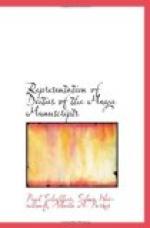This goddess occurs only in the Madrid manuscript and is distinguished by the solitary tooth in the under jaw, as a sign of age, the invariable characteristic of aged persons in the manuscripts. She is pictured in the following places: Tro. 5*c, 6*b, and 11*b, c and d, Cort. 10b, 11a, 38a. In Tro. 11* she is represented working at a loom. She does not appear at all in the Dresden and Paris manuscripts. The figures of women mentioned under I with the serpent on their heads, are especially not to be regarded as identical with goddess O, for she never wears the serpent, but a tuft of hair bound high up on her head and running out in two locks.
Her hieroglyph is Fig. 52; it is distinguished by the wrinkles of age about the eye. Owing to the limited number of her pictures, there is little to be said concerning the significance of this goddess.
P. The Frog-God.
[Illustration: Fig. 53]
We call him the frog-god because in the Codex Tro. 31, he is pictured in the first and second lines with the club-shaped fingers of a frog, which occur only on this figure. The blue background, which is his attribute twice in the same passage, likewise points to a connection with water, and that the god also has something to do with agriculture may be deduced from the fact that he is pictured sowing seed and making furrows with the planting-stick. The two black parallel stripes at the corner of the eye seem to be folds of skin or marks on the skin, which may represent a peculiarity of this particular species of frog. His head ornament is very characteristic and contains the sign for the year of 360 days. He therefore bears some unknown relation also to the computation of time. It should be recalled in this connection that one of the Maya months is called Uo, frog. The god is pictured again in Tro. 30a and b, Tro. 22 (top, scattering seed) and Cort. 5 (at the very bottom, the figure lying down). Finally his neck ornament must be mentioned, which, as a rule, consists of a neck-chain with pointed, oblong or pronged objects, probably shells.
In the Dresden manuscript he occurs but once, Dr. 4a (first figure), with some variations it is true. The text at this place contains H’s hieroglyph. God P does not occur in the Peresianus.
His hieroglyph is Fig. 53. It occurs in Tro. 31 (top) and can be unerringly recognized by the two black parallel stripes at the corner of the eye; which correspond exactly to the same marks on the face of the picture of the god himself.
This is all that can be said respecting this deity from the pictures in the manuscripts. Its meaning is obscure. Seler’s assumption that god P is Kukulcan (Zeitschrift fuer Ethnologie, 1898, p. 403) has certainly very slight foundation, and in view of the material from the manuscripts described in the preceding pages, it is in the highest degree improbable.
* * * * *




